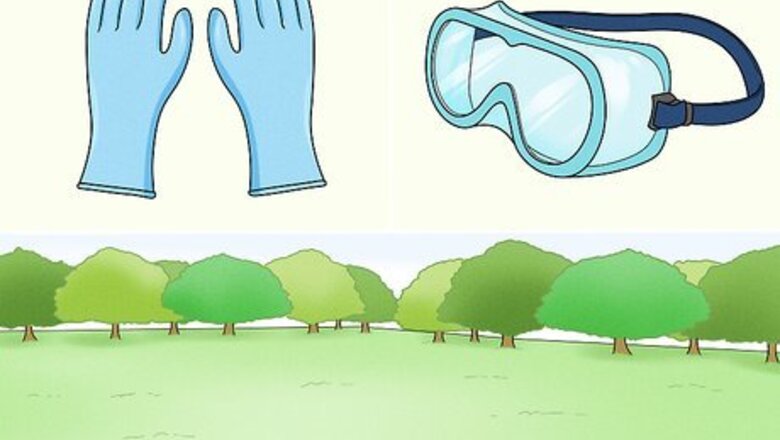
views
Warning: This project is very flammable and highly combustible. Keep your supplies and your rocket away from heat and open flames. Additionally, don’t light it from up close, as you may get injured.
Making the Rocket Body
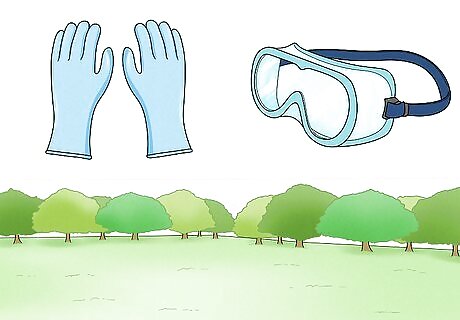
Put on your protective equipment and choose a safe area. This project is dangerous, so wear your personal protective gear at all times. At a minimum, wear work gloves and protective eyewear. Additionally, it’s best to wear long sleeves, long pants, and close-toed shoes. Go outside and choose a spot far away from heat sources. Keep your protective gear on at all times to stay safe. It's best to work on a rubber mat, which will prevent static build up and won't conduct electricity, which can trigger your propellant.Warning: Be sure to discharge static buildup by touching a grounded metal object. This can prevent you from accidentally releasing a static charge around your propellant. Tip: It's best to wear an air filtered respirator as you handle these ingredients because the particles are fine. You don't want to inhale them.
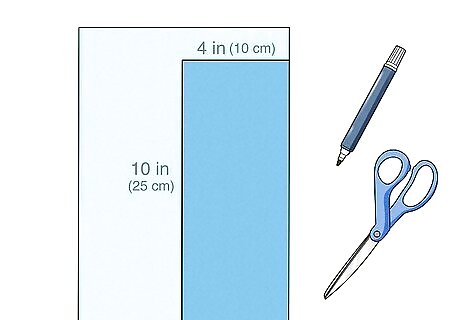
Cut a 4 by 10 in (10 by 25 cm) piece of 60-pound craft paper. Use a pencil to mark your paper where you need to cut. Then, use a pair of scissors to cut out the rectangle. It’s okay if your measurements are approximate, so don’t worry about cutting straight lines. Don’t use plastic tubes to make your rocket, as this is very dangerous. The material could explode or catch fire.
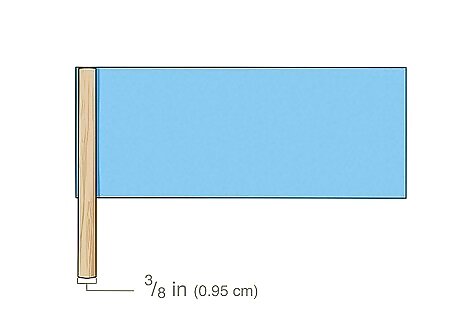
Lay a ⁄8 in (0.95 cm) wooden dowel across the short end of the paper. The dowel will help you make a hollow rocket body. Position your rod so that it’s in line with the short 4 in (10 cm) side of your paper. This will create a tube that’s 4 in (10 cm) long.

Roll the end of the paper around the dowel. Fold the edge of the paper up over the dowel, then roll the dowel across the paper until it's covered. Just cover the dowel in 1 layer of paper at this point because you need to add glue. You don’t want to create several layers of paper because it may tunnel out of your rocket body, since it’s not glued down.

Apply white school glue to the side of the paper that’s facing up. Squirt a thin layer of glue onto the exposed paper. Go around the edges to make sure that they stick down firmly. Then, add glue to the body of the paper, as well. This will help you create a sturdy rocket body out of your paper. Once the glue dries, your paper will be a thick cylinder.

Continue rolling the rest of the paper around the wooden dowel. Slowly roll the dowel across the paper, being careful to match up the edges of the paper. Smooth out the glue as you roll so that the final product is even and well-constructed. If there is excess glue at the edge of the paper when you finish rolling, wipe it off with a paper towel or a piece of scrap paper.
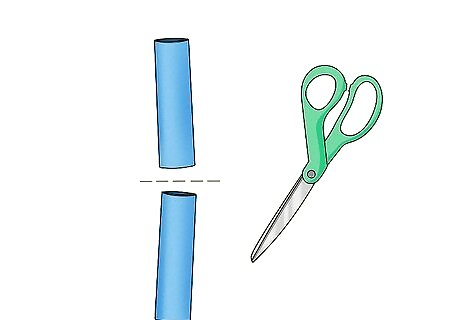
Cut your tube in half once it’s dry to create 2 rocket bodies. Use your scissors to cut through the tube at the halfway point. This will create 2 rocket bodies that are each 2 in (5.1 cm) long. Don’t let their size fool you! These rockets will still be powerful.Warning: Only work on 1 rocket at a time so you can do it safely. If there's an accident, having more than 1 rocket in progress will make it more dangerous.
Adding Cat Litter Cement
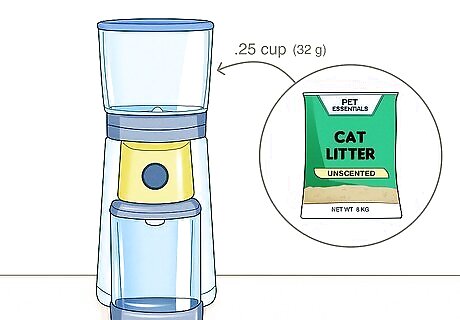
Put about .25 cup (32 g) of unscented cat litter into a grinder. Use a coffee grinder, mortar and pestle, or blender. However, keep in mind that you may damage the blade on your grinder or blender. Pick the cheapest cat litter you can find. It’s actually bentonite clay, which is why it works for this project.

Grind the cat litter until you have a powder. Turn on your coffee grinder or blender, if you’re using one. If you’re using a mortar and pestle, apply firm pressure as you manually grind the cat litter. Keep grinding until you have a powder. If you’re using a blender, hold it at an angle to speed up the process while also reducing the stress on the blender motor.
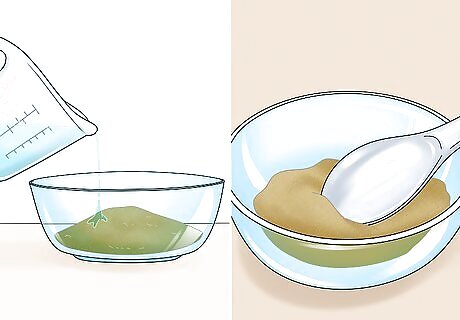
Add enough water to your cat litter to create a paste. Sprinkle a few drops of water onto your cat litter, then knead the water and litter to create a paste. Add more water as needed to make a paste consistency. This will make it easier to pack your tube. It’s okay to have a thick, lumpy paste, so add as little water as you can.
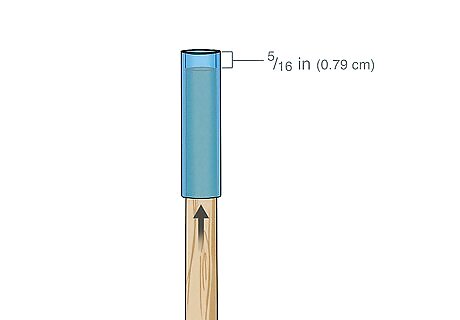
Insert the dowel into your rocket body, leaving a ⁄16 in (0.79 cm) gap. The gap at the end is where you’ll insert your cat litter paste. Hold the dowel in place while you pack the paste into the end of the tube. You may want to use a marker to draw a line on your dowel at the ⁄16 in (0.79 cm) point so it’s easier to measure this out.
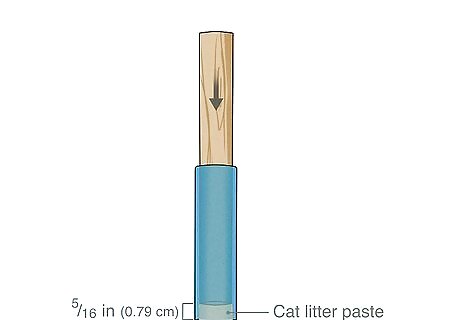
Pack the cat litter paste into the end of the tube. Use your gloved fingers to insert cat litter paste into the open end of your tube. Then, pack the paste down until feels solid. This will keep your rocket fuel inside the rocket body.Variation: As another option, you can use water putty to seal off the ends of your rocket. Simply mix enough water into your putty to make a paste. Then, pack it into the end of your rocket.
Mixing Your Rocket Fuel
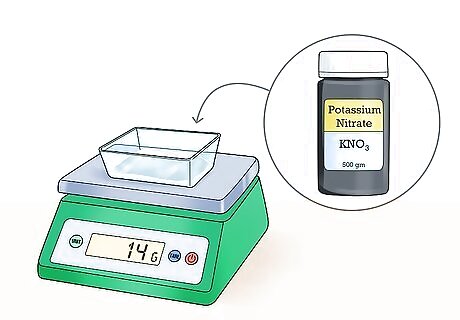
Add 14 grams of potassium nitrate to a plastic container. Potassium nitrate is also called KNO3. It helps supply a steady stream of oxygen to your sugar fuel so that it keeps burning. Measure out your potassium nitrate using a standard kitchen scale. You can buy pure potassium nitrate online. Alternatively, look for potassium nitrate at your local home improvement or gardening store. It’s often sold as stump remover. You may need to refine your potassium nitrate if you bought it as stump remover. If it's not 100% KNO3, dissolve it in boiling water and strain it through a paper filter. Discard the filter and solids, then boil off remaining water to get mostly pure KNO3. Leave in a hot area or minimum-temperature oven until completely dry.
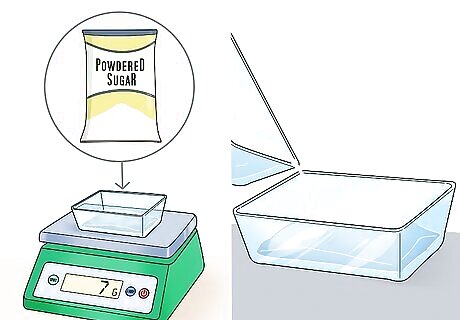
Measure out 7 grams of powdered sugar and add it to the container. Zero out your kitchen scale, then add 7 grams of powdered sugar to the container of potassium nitrate. Handle the container carefully because the materials are combustible. While it's optional, adding 1% dextrin to your mix may help make your propellant more stable. If you decide to add it, reduce your potassium nitrate and powdered sugar measurements by .5% each. For the mix above, you can just add 1 gram of dextrin to the mix since the measurements are so small.Warning: Together, potassium nitrate and powdered sugar are very flammable and highly combustible. Don’t put your container near a heat source or an electric machine.
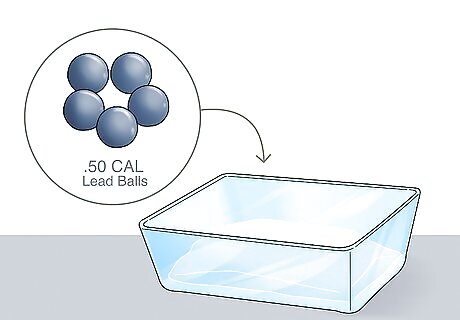
Add 5 lead fishing baits or .50-caliber lead balls to the container. The lead baits or balls will help you mix your ingredients thoroughly but safely. Put the lead pieces on top of your powdered mixture. Then, put the lid on the container.Warning: Only use lead to mix your rocket fuel. Other metals will create sparks and may explode. Do NOT use metals other than lead.
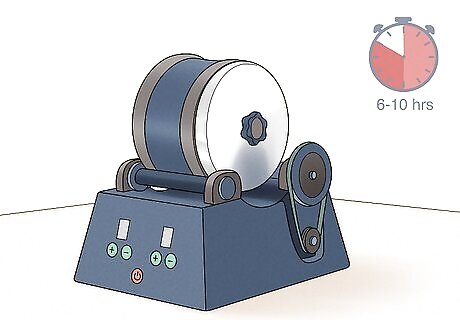
Mix your propellant in a rock tumbler for 6-10 hours for best results. A rock tumbler will mix your ingredients more thoroughly so your rocket has better thrust. Put the potassium nitrate and powdered sugar into a rock tumbler. Then, bring your rock tumbler outside while you mix the propellant. Turn the rock tumbler on and set a timer for at least 6 hours. It's best to place your mixer in a hole in the ground so that accidental blasts are controlled. Leave the top of the hole open to direct the blast upward. Make sure the rock tumbler is far away from other heat sources. Work in small batches until you're very experienced in working with propellant. This will reduce the risk of a fire or explosion.Tip: You need to use your propellant within 3 weeks of mixing it because it will start to lose its thrust. Additionally, the powdered sugar can attract moisture that may ruin the propellant. Be sure to keep it in an airtight container.
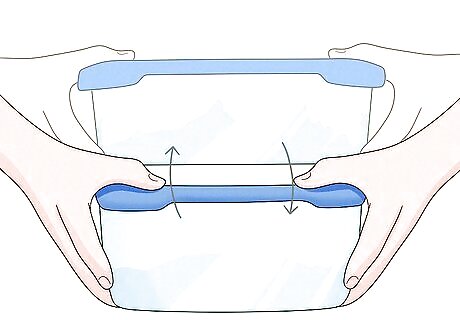
Shake the container to mix the ingredients as an alternative. Shaking won't mix your ingredients as well, and you'll need to do it for at least an hour total. With the lid on the container, manually shake it back and forth to mix up your rocket fuel. Be sure to stand away from heat sources and open flames. Remember, this mixture is highly flammable. This is an easy way to mimic the action of “ball milling,” which is how pyrotechnicians mix combustibles.
Finishing Your Rocket
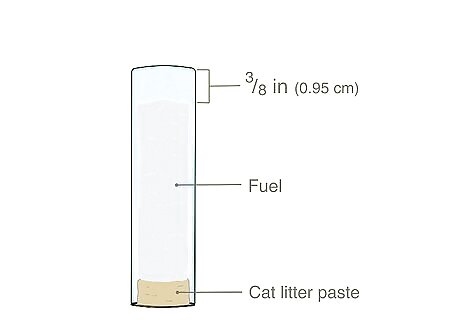
Pack the fuel into the container, leaving a ⁄8 in (0.95 cm) gap at the top. Add a small amount of rocket fuel to the rocket body, then use your dowel to pack it down. Continue adding and packing your rocket fuel until you reach the point where there’s ⁄8 in (0.95 cm) of empty tube left at the top. The extra space at the top is for another layer of cat litter paste. This will help you safely launch your rocket.Warning: It's possible to ignite the propellant if you strike it too hard because of the makeup of the potassium nitrate. This is rare, but you want to be careful. Additionally, it's important to slide your tools into the rocket body slowly so that air doesn't get trapped. If you push air down too quickly, it may ignite the propellant.
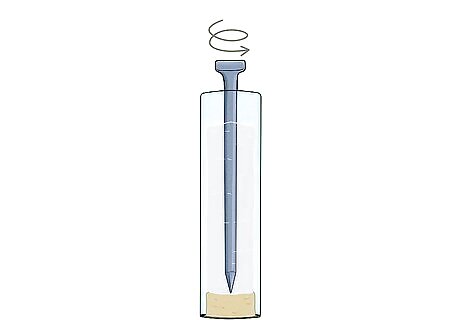
Twist a 6D nail through the center of the fuel and litter to make a core. Put the point of the nail at the center of the rocket fuel. Then, slowly work the nail through the center of the tube. Go through the rocket fuel and the cat litter paste. Then, rotate the nail slowly as you pull it out so that the hole will remain. This provides more surface area for your fuel to burn. You can find a 6D nail at your local hardware store. Any thin nail will work.Tip: It's best to invest in a rocket spindle, which creates rocket cores easily. You can find these in rocket kits or online.
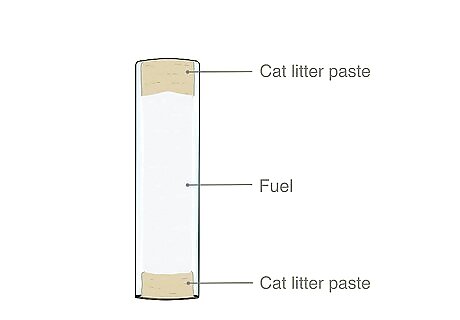
Make a cat litter paste and use it to cap off the rocket. Add a few drops of water to your cat litter and knead it into a paste. Then, use your gloved fingers to pack the paste into the end of the tube. This will cap off your rocket body. Remember, clumpy cat litter paste is okay, so don’t add a lot of water.
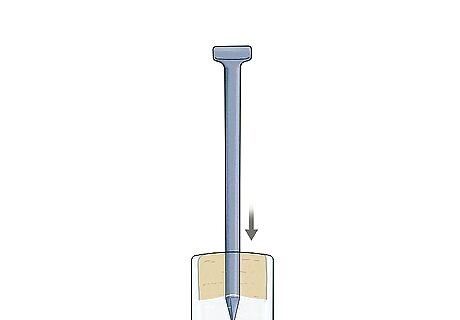
Use your 6D nail to poke a hole in the cat litter paste. Gently poke your nail through the cat litter paste so that your core goes through the entire rocket body. Rotate the nail as you remove it so that the hole remains. This will help your rocket burn evenly as it ignites.
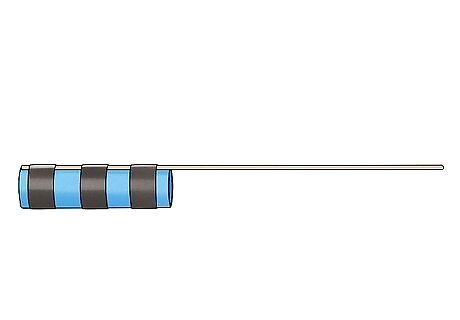
Tape a stick or skewer to your rocket so you can put it in the ground. Choose a thin stick or skewer that will be easy to poke into the ground. However, make sure it’s thick enough to support your rocket. Place the stick or skewer against the rocket body, then apply several layers of masking tape or electrical tape. You might prefer to glue the stick or skewer onto the rocket base first to make it more stable. However, this isn’t necessary.
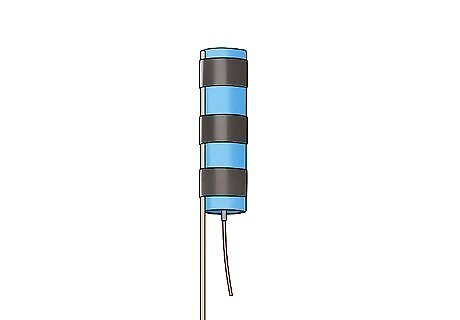
Insert a fuse into your core, leaving the end sticking out. Use your 6D nail to gently push the fuse up into the core, leaving a long end sticking out. If the fuse is smaller than the core, you may want to fold it over first so that it sticks up inside the rocket. Pack a wad of paper behind the fuse to keep it in place. If you're not using the rocket right away, fit a small piece of plastic wrap over the base of your rocket, then use a tiny amount of hot glue or white school glue to seal around the edges. This will keep it airtight. The fuse should go up into the core of the rocket so that it lights the fuel. Additionally, you want a long tail on your fuse to allow you time to move to safety.
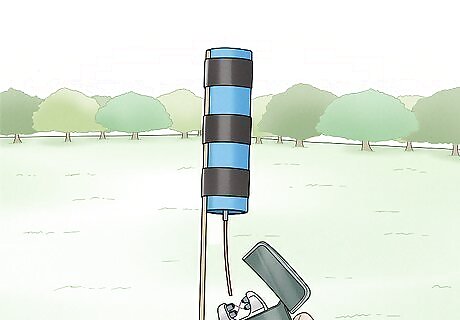
Put your rocket into the ground in an open space before lighting it. Choose an area that’s far away from buildings, people, pets, trees, and flammable objects. Additionally, check with the person who owns the land to make sure you have permission. Stand far away from your rocket when you light it. It's best to use an electric ignition to light your rocket so you can stand at a safe distance.



















Comments
0 comment